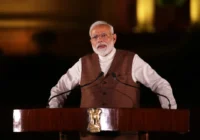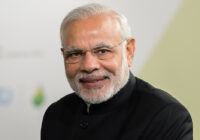In the realm of international diplomacy, where every gesture is scrutinized and every word weighed, Indian Prime Minister Narendra Modi has introduced a refreshing and somewhat controversial element: the hug. This seemingly simple physical act has become a hallmark of his diplomatic style, sparking discussions and debates across the global political landscape. But to understand the significance of Modi’s “hug diplomacy,” we must delve deeper into the cultural, historical and diplomatic contexts that frame this gesture.
On July 9, 2024, Modi embraced Russian President Vladimir Putin, to the chagrin of Ukrainian President Volodymyr Zelenskyy. In the following media briefing, Indian Foreign Minister Subrahmanyam Jaishankar defended the prime minister, noting, “In our part of the world, when people meet people, they are given to embracing each other. It may not be part of your culture, but I assure you, it’s part of ours.” This statement encapsulates the cultural divide that Modi’s hugs often bridge and the misunderstandings they sometimes generate.
Historical embracing in India and beyond
In India, embracing, or Aalingan, is deeply rooted in cultural and spiritual traditions. It’s not merely a greeting but a profound expression of trust, respect and connection that transcends verbal communication. This practice finds its origins in ancient Indian epics and spiritual texts.
In the Ramayana, one of India’s most revered epics, the embrace between the gods Lord Rama and Hanuman symbolizes not just friendship, but a deep, spiritual bond. Similarly, in the epic Mahābhārata, the god Krishna’s embraces with his friends and devotees are portrayed as acts of divine love, emphasizing the spiritual significance of physical connection.
The concept of Aalingan extends beyond mythology into everyday Indian life. It is a common form of greeting in many communities, especially among family members and close friends. It’s seen as a way to express affection, offer comfort and strengthen bonds between individuals.
While Modi’s hugs are rooted in Indian tradition, the act of embracing as a form of greeting or expression of kindness is not unique to India. Throughout history and across various cultures, this action has played significant roles in social and diplomatic interactions.
In ancient Greece, the concept of aspasmós referred to a greeting that often included an embrace. The Greeks, known for their emphasis on personal relationships and philosophical discourse, understood the power of physical connection in fostering mutual understanding. In Greek literature, this contact often signifies an emotional reunion or reconciliation between former enemies. Think of the embrace between the disguised Odysseus and his wife Penelope at the end of Odyssey. At first, Penelope does not believe Odysseus when he reveals his identity. Their hug signifies both reunion and the restoration of trust.
The Romans, too, recognized the importance of physical gestures in both personal and diplomatic contexts. The Latin terms amplexus (“embrace”) and complexus (“entwining”) were used to describe close physical contact that conveyed sincerity and built trust. In ancient Rome, the embrace signified brotherhood and common purpose. The celebrated Portrait of the Four Tetrarchs, depicting the four Roman co-emperors in a mutual embrace, amply demonstrates this custom.

Portrait of the Four Tetrarchs, Venice, Italy.
In the Middle Ages, the “kiss of peace,” or Pax, was a common greeting among European nobility and clergy, often accompanied by an embrace. This practice, rooted in early Christian traditions, was seen as a way to express unity and reconciliation within the community.
Even in cultures where physical contact is generally more reserved, there are historical instances of embraces being used in diplomatic contexts. For example, the famous “socialist fraternal kiss” between Soviet leader Leonid Brezhnev and East German leader Erich Honecker in 1979 became an iconic image of Cold War diplomacy.

Depiction of the socialist fraternal kiss in Berlin, Germany. Via LBM1948 on Wikimedia Commons (CC BY-SA 4.0).
The strategic significance of Modi’s hugs
Against this rich historical backdrop, Modi’s embraces take on a deeper significance. They are not just spontaneous displays of affection but calculated diplomatic moves that bridge ancient traditions with modern international relations.
Geopolitics are often cold and formal; interactions are guided by strict protocols and careful words. Touch, therefore, serves as a disruptive force. It humanizes interactions, breaks down barriers, and creates a sense of intimacy that few other diplomatic gestures can achieve.
When Modi embraces a world leader, he is sending a clear message: India values personal connections, and relationships are built on more than just agreements and treaties. This approach aligns with India’s broader diplomatic strategy, which emphasizes soft power and cultural diplomacy as key tools in its international relations.
To dismiss these hugs as mere quirks or cultural misunderstandings would be to underestimate their strategic significance. In a world where geopolitical tensions often dominate headlines, these embraces serve as powerful symbols of unity and shared humanity.
Modi’s embraces have become a unique form of non-verbal communication in his diplomatic toolkit. They can convey warmth where words might fail, break ice in tense situations or reinforce the strength of existing relationships. In some cases, they have even become newsworthy events in themselves, drawing attention to India’s diplomatic engagements and the prime minister’s personal brand of leadership.
Moreover, these hugs align with India’s aspirations on the global stage. As India seeks to position itself as a bridge between East and West, North and South, Modi’s hugs symbolize the country’s ability to connect diverse cultures and political systems.
This “hug diplomacy” has drawn criticism, however. Some view the embraces as overly familiar or even culturally insensitive, especially when dealing with leaders from more reserved cultures. Others argue that such gestures can be seen as unprofessional or distracting from substantive diplomatic issues.
There’s also the risk of overuse. If every diplomatic meeting ends with this gesture, does it lose its significance? Critics argue that the frequency of the prime minister’s embraces might dilute their impact or make them seem less sincere.
The power of human connection
Despite these challenges, the enduring popularity and discussion surrounding Modi’s hugs speak to a fundamental truth about human interaction: Physical connection matters. In a world increasingly dominated by digital communication and remote interactions, a simple embrace can carry profound meaning.
As the ancient Greeks and Romans understood, and as Indian tradition has long emphasized, physical gestures can convey what words often cannot. They can build trust, foster goodwill and create lasting impressions in ways that formal speeches or written agreements cannot.
Modi’s “hug diplomacy” is more than just a quirky diplomatic style; it’s a bridge between ancient cultural practices and modern diplomatic strategies. Drawing from the rich traditions of Aalingan in India and echoing touch’s historical significance across cultures, the hugs serve as a powerful reminder of our shared humanity in a divided world.
As we continue to navigate the complex, high-stakes landscape of international relations, perhaps we should view these embraces not as oddities to be questioned, but as invitations to consider the role of personal connection in diplomacy. While divisions seem to grow by the day, a warm human touch might just be the simplest yet most profound way to unite us.
As the saying goes, “hugs are the universal medicine.” Sometimes the most effective solution can be a heartfelt embrace.
[Lee Thompson-Kolar edited this piece.]
The views expressed in this article are the author’s own and do not necessarily reflect Fair Observer’s editorial policy.
Support Fair Observer
We rely on your support for our independence, diversity and quality.
For more than 10 years, Fair Observer has been free, fair and independent. No billionaire owns us, no advertisers control us. We are a reader-supported nonprofit. Unlike many other publications, we keep our content free for readers regardless of where they live or whether they can afford to pay. We have no paywalls and no ads.
In the post-truth era of fake news, echo chambers and filter bubbles, we publish a plurality of perspectives from around the world. Anyone can publish with us, but everyone goes through a rigorous editorial process. So, you get fact-checked, well-reasoned content instead of noise.
We publish 2,500+ voices from 90+ countries. We also conduct education and training programs
on subjects ranging from digital media and journalism to writing and critical thinking. This
doesn’t come cheap. Servers, editors, trainers and web developers cost
money.
Please consider supporting us on a regular basis as a recurring donor or a
sustaining member.
Will you support FO’s journalism?
We rely on your support for our independence, diversity and quality.








Comment